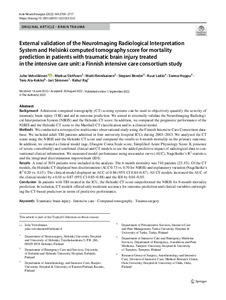External validation of the NeuroImaging Radiological Interpretation System and Helsinki computed tomography score for mortality prediction in patients with traumatic brain injury treated in the intensive care unit: a Finnish intensive care consortium study
Vehviläinen Juho; Skrifvars Markus; Reinikainen Matti; Bendel Stepani; Laitio Ruut; Hoppu Sanna; Ala-Kokko Tero; Siironen Jari; Raj Rahul
https://urn.fi/URN:NBN:fi-fe2022102463004
Tiivistelmä
Background Admission computed tomography (CT) scoring systems can be used to objectively quantify the severity of traumatic brain injury (TBI) and aid in outcome prediction. We aimed to externally validate the NeuroImaging Radiological Interpretation System (NIRIS) and the Helsinki CT score. In addition, we compared the prognostic performance of the NIRIS and the Helsinki CT score to the Marshall CT classification and to a clinical model.
Methods We conducted a retrospective multicenter observational study using the Finnish Intensive Care Consortium database. We included adult TBI patients admitted in four university hospital ICUs during 2003-2013. We analyzed the CT scans using the NIRIS and the Helsinki CT score and compared the results to 6-month mortality as the primary outcome. In addition, we created a clinical model (age, Glasgow Coma Scale score, Simplified Acute Physiology Score II, presence of severe comorbidity) and combined clinical and CT models to see the added predictive impact of radiological data to conventional clinical information. We measured model performance using area under curve (AUC), Nagelkerke's R2 statistics, and the integrated discrimination improvement (IDI).
Results A total of 3031 patients were included in the analysis. The 6-month mortality was 710 patients (23.4%). Of the CT models, the Helsinki CT displayed best discrimination (AUC 0.73 vs. 0.70 for NIRIS) and explanatory variation (Nagelkerke's R2 0.20 vs. 0.15). The clinical model displayed an AUC of 0.86 (95% CI 0.84-0.87). All CT models increased the AUC of the clinical model by + 0.01 to 0.87 (95% CI 0.85-0.88) and the IDI by 0.01-0.03.
Conclusion In patients with TBI treated in the ICU, the Helsinki CT score outperformed the NIRIS for 6-month mortality prediction. In isolation, CT models offered only moderate accuracy for outcome prediction and clinical variables outweighing the CT-based predictors in terms of predictive performance.
Kokoelmat
- Rinnakkaistallenteet [27094]
